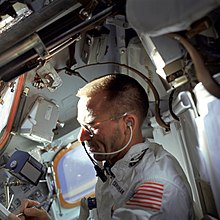Space pen
The space pen or astronaut pen is a ballpoint pen that was developed by the Fisher Space Pen Co. for astronaut missions and therefore also works reliably in space under the conditions of weightlessness ; there are now numerous models.
need
Pencil leads can easily break off and pose a danger to the astronauts, because broken parts float weightlessly around in space and can be inhaled easily, get into the eye or even - due to the electrically conductive graphite - lead to short circuits .
development
Paul C. Fisher founded the Fisher Pen Company in 1948 ; In 1953 he developed a universal ballpoint pen refill that fit into most ballpoint pen models and which was very successful on the market. In 1966 he developed and patented the ballpoint pen refill for the first space pen, the Fisher AG-7 (the acronym stands for "anti gravity"). The lead uses thixotropic ink paste, which is pressurized so that it flows even in weightlessness (or against gravity).
According to a newspaper interview, he received the recipe for the ink paste in a dream from his father; According to other information, he developed the Space Pen in collaboration with the Austrian inventor Friedrich Schächter , who created the overall concept for the space pen , and the mechanic Erwin Rath , who helped with the technical implementation.
In 1976 the company moved from Van Nuys, California to Boulder City , Nevada , USA . In 1986 the pseudonym Fisher Space Pen Co. was registered for the company .
properties
Except for the ink, the ballpoint pen refill is made entirely of metal and can withstand temperatures from −45 ° C to +120 ° C without being damaged. The mine is under pressure standing gas cartridge , a small metal cylinder inside which presses on the specialty ink. This technology makes it possible to write under conditions in which normal ballpoint pens do not work (e.g. the tip of the pen pointing upwards, on surfaces that are greasy or too smooth, such as plastics or glass, and under water).
NASA
Despite the potential problems, NASA used pencils on its first missions. In 1965, for example, a fixed-price agreement was signed with Tycam Engineering Manufacturing, Inc. for the Gemini program to supply 34 mechanical pencils for a total price of US $ 4,382.50 (US $ 128.89 each). This sparked criticism, as such a price was felt by many to be excessive. As a consequence, NASA canceled the contract and looked for a cheaper replacement.
In the same year, Fisher offered NASA the Space Pen. NASA hesitated at first, not least because of the great criticism of the Tycam contract. It was only after extensive testing in 1967 that the decision was made to use the pen for the Apollo mission . She initially bought 400 pens, priced at $ 6 each.
In February 1969, the Soviet Union also bought 100 space pens and 1000 ink cartridges for their Soyuz spaceships after they had previously used crayons there.
NASA has used it on every manned mission into space since 1968 . In the souvenir shops NASA this pin is often bought as souvenirs.
A modern legend is that NASA had the space pen developed for a million dollars, while the Soviet cosmonauts used a pencil for convenience. In fact, the development of the pen was not carried out on behalf of and without financial support from NASA, while pencils actually pose a risk in weightlessness for safety reasons (see above). In Germany this rumor was, among others, by the coverage of the ARD for the moon landing , stoked as one of the presenters in the studio told the story. After 2006, a commercial for the newspaper Handelsblatt gave the saga a new spread.
See also
Web links
Individual evidence
- ^ Peter Müller "Österreich innovativ", Jugend und Volk, Vienna-Munich, 1979, p. 75
- ^ A b Steve Garber : The Fisher Space Pen . National Aeronautics and Space Administration (NASA) , accessed July 11, 2013 .
- ↑ The billion-dollar space pen , by Dwayne A. Day (Engl.)
- ↑ BBDO Germany "Space Pen" Spot of the Year, Version from September 27, 2007 ( Memento from September 29, 2007 in the Internet Archive )

